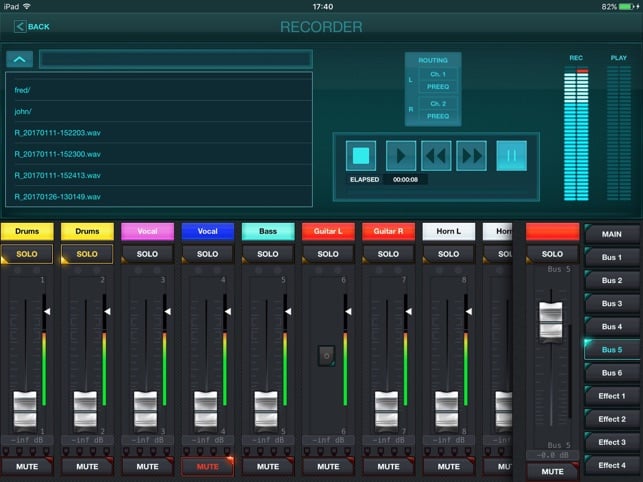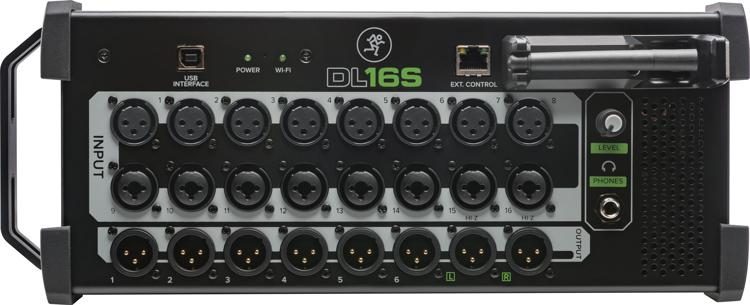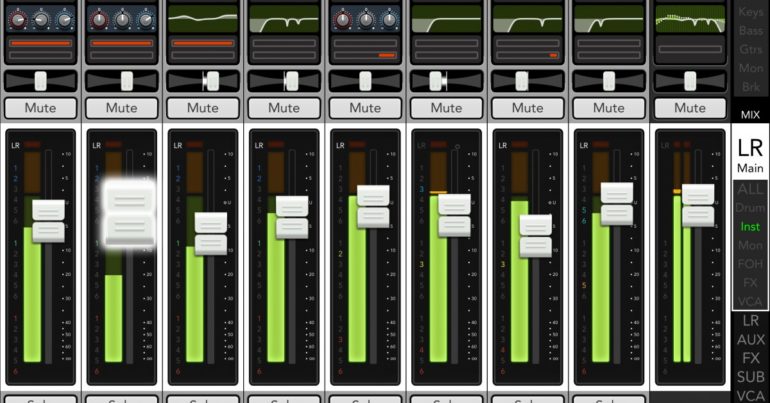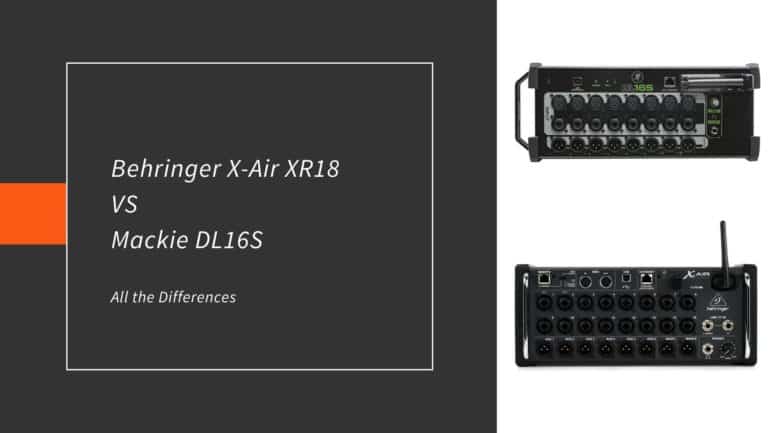Last updated on December 30th, 2023 at 02:52 pm
Two of the most popular Wireless mixers on the market today are the Behringer XR18 and the Mackie DL16S.
Both of them are pretty good mixers which offer multitrack recording.
Having this feature really comes in handy both for live shows as well as home studios, which means that getting one of these will negate the need for purchasing another mixer just for your home studio.
In this post I’ll go over both their features as well as their differences, and at the end I’ll tell you which one I prefer, since I think there’s a definite winner.
Let’s get right into it…
Behringer X Air XR18

The Behringer XR18 is a digital mixer which features a 18-in/18-out USB audio interface.
This basically means that every one of those 18 inputs can be recorded on-to its own track in the DAW.
Let’s take a quick look at the Behringer XR18’s inputs and outputs:
Inputs: 16 of the inputs are XLR/TRS combo Jacks which feature their famous MIDAS preamps, and an additional 2 x TRS line inputs, as well as MIDI I/O.
The quality of these preamps is actually pretty good, providing you with an excellent signal-to-noise ratio and good headroom.
Both of the first two inputs are also Hi-Z inputs, which allow you to connect an electric guitar without the need of using a D.I. box.
Outputs: As far as the outputs go, it comes with 2 x XLR Main outputs, the ultranet port, 6 XLR Aux bus outs, and ¼” TRS headphone output.
The 6 aux outputs can be used to create headphone mixes, or for live monitoring…
While the “Ultranet” port, which connects to the Behringer’s P16 monitor distribution system, allows every musician to create their own headphone mix or their own monitor mix on stage.
The Behringer X-Air XR18 can be controlled via Wi-Fi -with a built-in router- or ethernet, using an Andrioid or iOS device via the X-Air App, which gives you an overview of what’s going on in the mixer.
This app works almost like a DAW and comes included with loads of effects.
Here’s how the X-Air App looks;

It even has an Auto-Mix feature which can manage fully automated mixes with up to 16 live microphones…
This feature, however, is not really intended for mixing live music, but rather conferences.
When it comes to cost-efficiency, the Behringer XR18 is one of the best wireless multitrack mixers out there…
It super affordable for what you are getting.
Onboard Effects
As far as the effects go, it comes with four built-in true-stereo (8 mono) multi-effects processors, including delay, chorus, and dynamics, as well as a 31-band EQ.
You can also choose any combination of high-end simulations of classic studio reverbs such as the Lexicon 480L and PCM70, the EMT250 or Quantec QRS.
Sadly, there is no included feedback rejection/feedback fighting on these mixers, as well as no amp simulation, which do come included with the Soundcraft mixers.
Features
- 18-in/18-out USB interface which allows for multitrack recording
- Good onboard effects
- Midas preamps
- Durable and portable build
Specifications
| Model | Behringer XR18 |
| Channels | 18 |
| Inputs | 16 x XLR/TRS, 2 x ¼” line |
| Outputs | 2 x XLR main, ultranet port, 6 XLR AUX |
| MIDI I/O | Yes |
| Headphone Output | 1 x ¼” TRS |
| EQ | 100-band Real Time Analyzer (RTA) |
| Rackmountable | Yes |
| Multi-track Recording | Yes |
| USB Rec/Playback | No |
| App required | X-Air App |
| Feedback Control | No |
Find out more about the Behringer X Air XR18 here:
- Behringer X Air XR18: Amazon, Sweetwater.
Related: If you’re looking for other good mixers, here are a couple posts on those topics:
Moving on…
Mackie DL16S and DL32S

The Mackie DL16S is a wireless digital mixer that features a 16-in/16-out audio interfaces, which basically means that all of the inputs can be recorded on-to their own tracks in your DAW.
All of the inputs come with the Onyx+ preamps which are one of the best preamps out there and should provide you with a lot of headroom and a great signal-to-noise ratio.
Speaking of inputs, let’s take a look at them right now, as well as the outputs…
The inputs on the DL16S are: 8 x XLR inputs, 6 x XLR/TRS combo jacks, 2 x XLR/TRS Combo Hi-Z inputs.
The outputs are: 2 x XLR Main outputs, 6 x XLR (Assignable) outputs, and a 1 x ¼” TRS headphone output.
Since this is a wireless mixer it means that it doesn’t come with the usual channel strips but it can rather be controlled via Mackie’s “Master Fader App” which can be used on almost any iOS, Android, Mac, or PC device.
What this means is that you can set the mixer up on stage and control it from anywhere you’d like.
Same goes for your home studio, since you can set it up in a way where it’s completely out of the way, and then all you need to do is use the app to control it.
In all honesty, I’m more of fan of actual faders and knobs when it comes to studios, but that’s just me!
If you’re like me, then here’s a complete post about the best home studio mixers.
The Master Fader app is fairly easy to use since it’s extremely intuitive, but if you want to see a video of how it works, then either scroll back up the review of the Mackie DL1608, or click on this YouTube link.
Here’s how it looks;

The Mackie DL16S allows for up to 20 simultaneous Wi-Fi connections, which is actually way more than what the Behringer supports.
The great thing about being able to have so many devices connected simultaneously is that the band members who are playing on stage, can actually control their own monitor/headphone mix without needing to bother the engineer.
This mixer also allows you to play back music during intermissions, backing tracks, etc. and it also allows you to play back the full multitrack recording for a virtual sound check.
Onboard Effects
Each input comes with a 4-band parametric EQ, high-pass filter, noise gate, and compression.
While each output comes with a 4-band parametric EQ, highpass and lowpass filters, 31-band graphic EQ, compressor/limiter, and alignment delay.
Additionally, the mixer provides reverb, delay, and modulation effects.
Sadly, there’s no Feedback Control built into it, or any sort of amp sims like on the Soundcraft Wireless mixers.
Features
- 16-in/16-out Audio Interface which allows for multitrack recording.
- Play intermission music, backing tracks, and more
- Play back your full multitrack recording for a virtual sound check
- Supports up to 20 connected devices through Wi-Fi
Specifications
| Model | Mackie DL16S | Mackie DL32S |
| Channels | 16 | 32 |
| Inputs | 8 x XLR, 6 x XLR/TRS combo, 2 x XLR/¼” Hi-Z | 16 x XLR, 14 x XLR/TRS Combo, 2 x XLR/¼” Hi-Z |
| Outputs | 2 x XLR, 6 XLR Assignable | 2 x XLR, 8 XLR Assignable |
| MIDI I/O | No | No |
| Headphone Output | 1 x ¼” | 1 x ¼” |
| EQ Bands | 4-band Parametric EQ, Highpass Filter | 4-band Parametric EQ, Highpass Filter |
| Rackmountable | Yes | Yes |
| Multi-track Recording | Yes | Yes |
| USB Rec/Playback | Yes, but not to Pen Drive | Yes, but not to Pen Drive |
| App Required | Master Fader App | Master Fader App |
| Feedback Control | No | No |
Find out more about the Mackie DL16S and DL32S here:
- Mackie DL16S: Amazon, Sweetwater.
- Mackie DL32S: Amazon, Sweetwater.
Differences
The Behringer XR18 features the Ultranet port, MIDI In/Out, and a 3-way ethernet/Wi-Fi switch for multiple control modes.
None of these features are included in the Mackie DL16S.
On the other hand, the Mackie DL16S supports up to 20 simultaneous Wi-Fi devices.
Other than this, there are no major differences.
Which one should you get?
With the Mackie DL16S going for almost 50% more and without offering anything significant over the Behringer XR18, I think it’s fair to assume that the Behringer XR18 would be your overall best bet…
Especially when taking cost-effectiveness into consideration.
Conclusion
Both of these mixers are great, both for live shows as well as home studios, however like I just mentioned, I think that the Behringer XR18 wins this contest.
Especially since it’s so much more affordable!
I hope this information was useful!
Have a great day!
